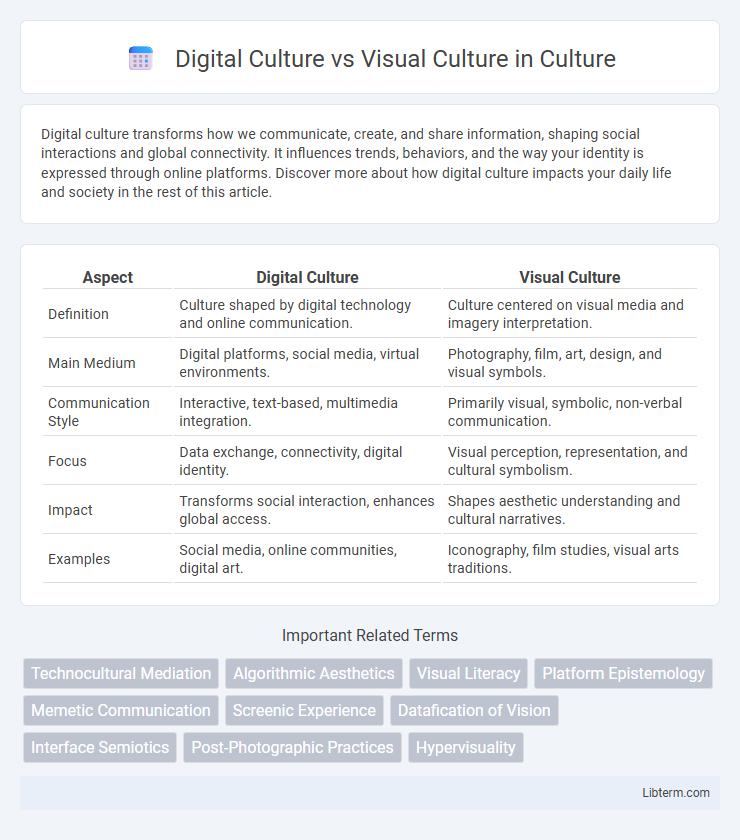Digital culture transforms how we communicate, create, and share information, shaping social interactions and global connectivity. It influences trends, behaviors, and the way your identity is expressed through online platforms. Discover more about how digital culture impacts your daily life and society in the rest of this article.
Table of Comparison
| Aspect | Digital Culture | Visual Culture |
|---|---|---|
| Definition | Culture shaped by digital technology and online communication. | Culture centered on visual media and imagery interpretation. |
| Main Medium | Digital platforms, social media, virtual environments. | Photography, film, art, design, and visual symbols. |
| Communication Style | Interactive, text-based, multimedia integration. | Primarily visual, symbolic, non-verbal communication. |
| Focus | Data exchange, connectivity, digital identity. | Visual perception, representation, and cultural symbolism. |
| Impact | Transforms social interaction, enhances global access. | Shapes aesthetic understanding and cultural narratives. |
| Examples | Social media, online communities, digital art. | Iconography, film studies, visual arts traditions. |
Understanding Digital Culture
Understanding digital culture involves exploring how technology shapes social behaviors, communication, and identity formation in online environments. It encompasses the practices, norms, and values emerging from digital interactions, including social media, virtual communities, and digital content creation. Unlike visual culture, which centers on the interpretation of visual media, digital culture integrates multimedia, interactivity, and networked connectivity to redefine cultural participation and expression.
Defining Visual Culture
Visual culture encompasses the practices, institutions, and artifacts related to visual perception and representation, including art, media, design, and everyday imagery. It examines how images function in society to shape identities, convey meanings, and influence cultural norms. Unlike digital culture, which centers on digital technology and online interactions, visual culture broadly spans analog and digital visual experiences.
Historical Evolution of Both Cultures
Digital culture emerged in the late 20th century with the advent of computers and the internet, transforming communication, information sharing, and social interactions through virtual platforms. Visual culture's roots trace back to ancient civilizations, evolving through art, photography, film, and television as pivotal mediums for shaping societal values and historical narratives. The transition from analog to digital technologies marks a significant shift, blending visual culture's imagery-centric traditions with digital culture's interactivity and instantaneous global reach.
Key Differences Between Digital and Visual Culture
Digital culture centers around interactive technologies, social media platforms, and virtual environments that shape online behavior and communication patterns. Visual culture emphasizes the creation, interpretation, and impact of images, symbols, and visual media in both traditional and contemporary contexts. Key differences lie in digital culture's dynamic, participatory nature contrasted with visual culture's focus on visual representation and interpretation across various media forms.
Overlapping Elements: Where Digital Meets Visual
Digital culture and visual culture intersect through the pervasive use of multimedia technologies that integrate images, videos, and interactive graphics into everyday communication. Platforms like social media exemplify this overlap by enabling the creation, sharing, and consumption of visually-driven digital content that shapes social narratives and identity formation. The convergence of augmented reality (AR) and virtual reality (VR) further blurs boundaries, fostering immersive visual experiences rooted in digital environments.
Impact of Technology on Cultural Perception
Technology has revolutionized digital culture by enabling immersive experiences, interactive media, and global connectivity that reshape how individuals engage with cultural content. Visual culture, traditionally centered on static images and art forms, now incorporates dynamic digital visuals, augmented reality, and virtual environments, influencing cultural perception through multi-sensory engagement. The integration of digital tools transforms cultural narratives, expanding access and diversifying interpretations across societies worldwide.
The Role of Social Media in Shaping Cultures
Social media platforms play a pivotal role in shaping digital culture by enabling rapid dissemination and consumption of content, fostering global connectivity, and influencing identity construction. Visual culture, deeply intertwined with digital media, relies heavily on imagery, videos, and memes circulated through social networks to convey meanings and cultural narratives. Algorithms on platforms like Instagram, TikTok, and Facebook amplify certain visual content, thereby shaping cultural trends and collective digital experiences.
Artistic Expression in Digital vs Visual Contexts
Artistic expression in digital culture leverages interactive technologies, virtual reality, and algorithmic creativity to create immersive, dynamic experiences that evolve with user input. Visual culture emphasizes static or time-based imagery, such as painting, photography, and film, prioritizing composition, color, and iconography to communicate symbolic meaning. Digital art expands traditional visual frameworks by integrating multimedia elements, interactivity, and digital manipulation, transforming how audiences engage with and interpret artistic content.
Societal Implications of Cultural Shifts
Digital culture transforms societal interactions by prioritizing virtual connectivity, reshaping norms around communication and identity formation. Visual culture emphasizes imagery and audiovisual media as primary conduits of meaning, influencing perception and social values. The shift from visual to digital paradigms challenges traditional media consumption patterns, affecting power structures and cultural participation in contemporary society.
Future Trends in Digital and Visual Culture
Future trends in digital culture emphasize immersive technologies such as augmented reality (AR) and virtual reality (VR), reshaping social interactions and content consumption. Visual culture increasingly integrates AI-generated imagery and deepfake technology, challenging traditional notions of authenticity and artistic creation. The convergence of digital and visual cultures will drive personalized, interactive experiences powered by machine learning and blockchain for secure digital ownership.
Digital Culture Infographic

 libterm.com
libterm.com